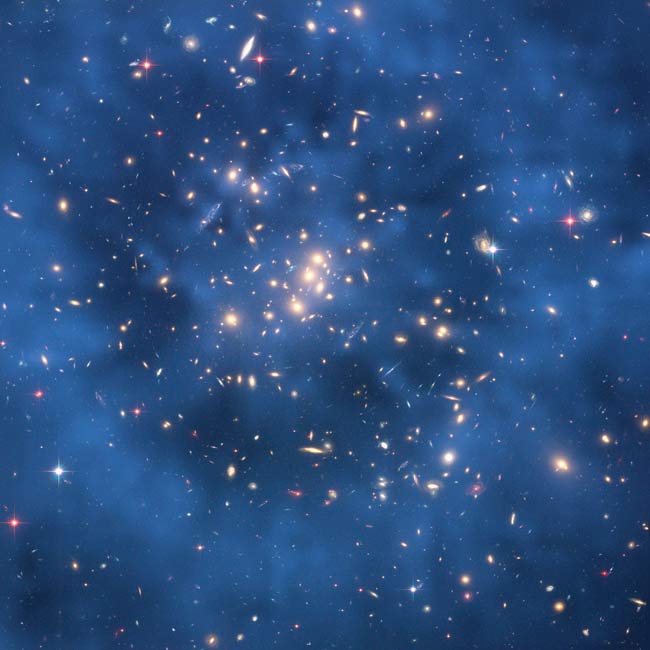Hubble Reveals Ghostly Ring of Dark Matter

Updatedat 2:34 pm EDT
Astronomershave discovered an enormous, ghostly ring of dark matter 5 billion light-yearsaway--the most blatant evidence to date for the existence of a mysterioussubstance hidden throughout the universe.
Dark mattermakes up a vast majority of gravity-exerting mass in the universe, while onlyabout 10 percent is matter we can see and touch. If darkmatter didn't exist, scientists say, galaxies like the Milky Way would havealready flown apart from a severe lack of gravitational "glue."
Researcherspointed the aging but powerful Hubble Space Telescopetoward a cluster of galaxies known as cluster ZwCl0024+1652. At first glance,the then-unknown ring lookedlike a ripple in a pond over the twinkling galactic cluster.
"I wasannoyed when I saw the ring because I thought it was an artifact," said MyungkookJames Jee of Johns Hopkins University.
But itwasn't a glitch, astronomers announced at a NASA press conference today.
The moreJee and others tried to remove the ring by tweaking the data, the more the ring-likeanomaly stuck out like a sore thumb. "It took more than a year toconvince myself that the ring was real," Jee said. "I've looked at a number ofclusters and I haven't seen anything like this."
Get the Space.com Newsletter
Breaking space news, the latest updates on rocket launches, skywatching events and more!
Because somuch dark matter resides in the ring, astronomers said, it bends the lightaround it to create the ripple effect--dark matter's calling card. The completefindings will be detailed in an upcoming issue of the Astrophysical Journal.
The ring,2.6-million light-years wide, formed when two huge clusters of galaxies slammedtogether in a head-on collision 6 to 7 billion years ago, puffing themysterious matter outward, the astronomers figure. If the galactic hit-and-runhad occurred outside of Earth's line-of-sight, the result might look more like the "Bulletcluster"--another cosmic impact site that astronomers view as strongevidence for dark matter.
RichardMassey, a Caltech astronomer not connected to the study, said that the findingis extremely important, especially combined with the Bullet cluster evidence.But he warned that the discovery still faces skepticism from other astronomers."A lot of things can go wrong in producing an image," he said, explaining the shapecould be produced within Hubble's camera itself.
Also, hesaid, the failure of Hubble's most powerful camera four months ago doesn'thelp. "Just as we were getting to the point to learn how to find dark matter,it breaks," Massey said.
RichardWhite, an astronomer with Space Telescope Science Institute in Maryland, said he also was initially skeptical about the ring of dark matter. "But it showsup in another Hubble camera's data as well," he said. "It's not as clear, butit's still there. We argue the ring has been seen twice now."
Unlikeother darkmatter discoveries, the ring is the first collection of dark matter thatdiffers greatly from the distribution of ordinary matter.
In additionto using gravity to visualizethe dark matter itself, the team also created computer simulations showingwhat happens when galaxy clusters collide. When the two clusters smashedtogether, they think, dark matter fell to the center and then sloshed outward.As it did so, gravity eventually slowed it down and condensed it into a largering detected by astronomers.
"Bystudying this collision, we are seeing how dark matter responds togravity," said Holland Ford, another Johns Hopkins astronomer on the team."Nature is doing an experiment for us that we can't do in a lab, and itagrees with our theoretical models."
Finding darkmatter is not easy because it doesn't shine or reflect light. So astronomers relyon gravity, which can bend thelight of distant stars when enough mass is present, much like a lensdistorts an image behind it. Thanks to the laws of physics, knowing how muchlight is bent tells astronomers how much mass is there. By mapping the gravity's"footprint," astronomers were able to create a picture of how the dark matter ring isdistributed in the cluster.
In theimage of the cluster, Jee said, "the background galaxies behind the ring showcoherent changes in their shapes due to the presence of the dense ring. It'slike looking at the pebbles on the bottom of a pond with ripples on the surface."
- Seethe Video: Dark Matter Ring
- TinyGalaxies Hide Dark Secret
- TheTop 10 Strangest Things in Space
Join our Space Forums to keep talking space on the latest missions, night sky and more! And if you have a news tip, correction or comment, let us know at: community@space.com.
Dave Mosher is currently a public relations executive at AST SpaceMobile, which aims to bring mobile broadband internet access to the half of humanity that currently lacks it. Before joining AST SpaceMobile, he was a senior correspondent at Insider and the online director at Popular Science. He has written for several news outlets in addition to Live Science and Space.com, including: Wired.com, National Geographic News, Scientific American, Simons Foundation and Discover Magazine.









